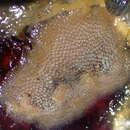mk
имиња во трошки


Cryptosula pallasiana is a species of colonial bryozoan in the order Cheilostomatida. It is native to the Atlantic Ocean where it occurs in northwestern Europe and northern Africa, and the eastern seaboard of North America. It has been accidentally introduced to the western coast of North America and to other parts of the world.
Cryptosula pallasiana is an encrusting colonial bryozoan with colonies growing to roughly circular patches with diameters of a few centimetres. Each colony consists of a number of individual organisms called zooids. Each zooid lies in a rigid rectangular box called a zooecium up to 1 mm (0.04 in) long and 0.5 mm (0.02 in) wide. These are fitted together in a regular pattern, radiating out from the position in which the founding zooid settled to start the colony, each daughter zooid's head being further away from the centre of the colony than its foot. The upper surface of the zooecium has an opening called the aperture at the head end, and through this the zooid's lophophore is extended to feed. The aperture is a round-cornered square and there are pores in the upper surface of the zooecium both above and below it. The colonies are white, beige, pink or orange.[2]
Cryptosula pallasiana is native to the North Atlantic Ocean. On the east side its range extends from Norway and the United Kingdom to the Mediterranean Sea, the Black Sea and Morocco. On the west side it ranges from Nova Scotia to Florida. It was first recorded in the Pacific Ocean in the 1940s, first in San Francisco Bay and Newport Bay (California), and later in other parts of California, British Columbia, Washington and Oregon. By the 1960s it had been reported from Japan, Hawaii, New Zealand, Australia, Argentina and Chile. It is a fouling organism and it is thought that it has spread on the hulls of vessels, and possibly with the transfer of oysters or other shellfish.[2]
This species grows in shallow water on many kinds of hard surface including rocks, pilings, docks, breakwaters, seaweed, sea grasses, shellfish, floating debris and the hulls of ships. Other invertebrates and juvenile fish find suitable habitat around the colonies. The zooids feed by extending their lophophores and filter feeding, extracting particles less than 0.045 mm (0.002 in) in diameter from the water.[3] The sea slug Okenia eolida feeds on fouling bryozoans including C. pallasiana, and has been transported around the world with them.[4]
Cryptosula pallasiana is a species of colonial bryozoan in the order Cheilostomatida. It is native to the Atlantic Ocean where it occurs in northwestern Europe and northern Africa, and the eastern seaboard of North America. It has been accidentally introduced to the western coast of North America and to other parts of the world.
Cryptosula pallasiana es una especie de Bryozoa que forma colonias en el orden Cheilostomata. Es nativa del Océano Atlántico, donde se encuentra en el noroeste de Europa y el norte de África y la costa este de América del Norte. Se ha introducido accidentalmente en la costa occidental de América del Norte y en otras partes del mundo.
Cryptosula pallasiana es una especie de Bryozoa incrustante con colonias que se convierten en parches aproximadamente circulares con diámetros de unos pocos centímetros. Cada colonia se compone de una serie de organismos individuales llamados zooides. Cada zooide se encuentra en un bloque rectangular rígido llamada zooecium de hasta 1 mm (0.04 in) de largo y 0.5 mm (0.02 in) de ancho. Estos se colocan juntos en un patrón regular, irradiando desde la posición en la que se asentó el zooide fundador para comenzar la colonia, y la cabeza del zooide de cada hija está más alejada del centro de la colonia que de su pie. La superficie superior del zooecium tiene una abertura en el extremo de la cabeza y, a través de esto, el lofóforo del zooide se extiende para alimentarse. La abertura es un cuadrado de esquinas redondeadas y hay poros en la superficie superior del zooecium tanto por encima como por debajo. Las colonias son blancas, beige, rosa o naranja.[2]
C. pallasiana es nativa del Océano Atlántico norte. En el lado este, su rango se extiende desde Noruega y el Reino Unido hasta el Mar Mediterráneo, el Mar Negro y Marruecos. En el lado oeste se extiende desde Nueva Escocia hasta Florida. Fue encontrado por primera vez en el Océano Pacífico en la década de 1940, primero en la Bahía de San Francisco y en la Bahía de Newport (California), y más tarde en otras partes de California, Columbia Británica, Washington y Oregón. En la década de 1960 se había informado de Japón, Hawái, Nueva Zelanda, Australia, Argentina y Chile. Es un organismo contaminante y se cree que se ha diseminado en los cascos de los buques, y posiblemente con la transferencia de ostras u otros mariscos.[2]
Esta especie crece en aguas poco profundas en muchos tipos de superficie dura, incluyendo rocas, pilotes, diques, rompeolas, algas marinas, pastos marinos, mariscos, escombros flotantes y los cascos de los barcos. Otros invertebrados y peces juveniles encuentran hábitat adecuado alrededor de las colonias. Los zooides se alimentan extendiendo sus lofóforos y filtrando, extrayendo partículas de menos de 0.045 mm (0.002 in) de diámetro del agua.[3] La babosa marina Okenia eolida se alimenta de briozoos incrustantes, incluida C. pallasiana , y ha sido transportada por todo el mundo con ellos.[4]
Cryptosula pallasiana es una especie de Bryozoa que forma colonias en el orden Cheilostomata. Es nativa del Océano Atlántico, donde se encuentra en el noroeste de Europa y el norte de África y la costa este de América del Norte. Se ha introducido accidentalmente en la costa occidental de América del Norte y en otras partes del mundo.
Cryptosula pallasiana is een mosdiertjessoort uit de familie van de Cryptosulidae.[1] De wetenschappelijke naam van de soort is voor het eerst geldig gepubliceerd in 1803 door Moll.
Bronnen, noten en/of referenties